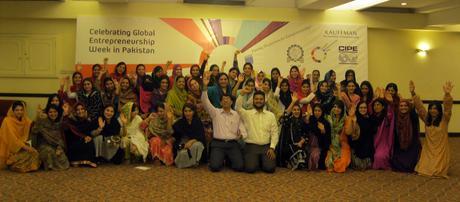
Women entrepreneurs celebrating Global Entrepreneurship Week in Pakistan.
Men in emerging economies significantly own more small and medium enterprises (SME) than women – women only represent about 38% of all SMEs. With all the strides that women entrepreneurs have made in the last decade – generating more employment, increasing trade, contributing to their local community development, and ultimately reducing poverty – why are not more women running their own businesses?
According to USAID’s Chief Economist Steve Radelet, there are five major constraints to women’s entrepreneurship.
- Legal and regulatory framework: from property rights to access to finance, women face myriad legal and regulatory challenges that prevent them from starting or formalizing enterprises.
- Cultural and social norms: in many countries, women do not fully participate in the labor force nor do they run businesses for cultural and social reasons.
- Lack of information and networks: compared to male business owners, women in business lack access to various information, including finance and technology. Moreover they often do not have networking opportunities to connect with other women entrepreneurs.
- Education: women are disproportionately less likely to have education in business skills.
- Tolerance for risk: compared to men, women entrepreneurs are risk-adverse with their business decision-making.
While these challenges are difficult to solve, many organizations are already addressing them. CIPE, for instance, works to remove the institutional and cultural barriers to women’s entrepreneurship – such as eliminating legal barriers to women’s economic participation in Pakistan, or easing access to credit for women entrepreneurs in Bangladesh.
On the educational front, Goldman Sachs’ 10,000 Women initiative provides management education for women in developing economies to develop their business skills, as well as building a network of women entrepreneurs worldwide. As for increasing access to finance, the Inter-American Development Bank (IDB) and the Multilateral Investment Fund are running the women entrepreneurshipBanking (weB) to provide incentives for banks to offer more lending services to women-owned SMEs. Other development agencies and financial firms are also looking for ways to involve more venture capitalists to finance women SMEs around the world.
Creating opportunities and reducing barriers for women entrepreneurs is a must. But as various groups get more involved in the process, it is crucial for all the actors to communicate and complement each other’s work. For example, USAID and World Bank’s new initiative, Women’s Leadership in Small & Medium Enterprises (WLSME), is a way to collaborate on innovative interventions to reduce the above mentioned barriers to entry and growth of female-led enterprises. Moving forward, as the development community, private sector, and governments continue to help empower women’s participation in the economy, we must learn from best practices and work towards the same goal.

